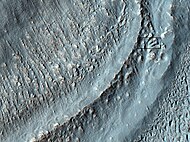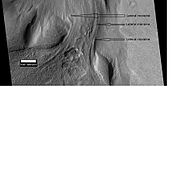Promethei Terra


Promethei Terra is a large Martian region covering 3300 km at its broadest extent. It lies to the east of the massive Hellas basin. Like much of the southern part of the planet it is a heavily cratered, highland region. Promethei Terra was named for a classic albedo feature of Mars, with the original name derived from that of the Greek god Prometheus. Promethei Terra lies mostly in the Hellas quadrangle of Mars.
Lobate debris aprons[edit]
One very important feature common in Promethei Terra are piles of material surrounding cliffs. These materials are called lobate debris aprons (LDAs). Recently, research with the Shallow Radar on the Mars Reconnaissance Orbiter has provided strong evidence that the LDAs are glaciers that are covered with a thin layer of rocks. Large amounts of water ice are believed to be in the LDAs. Available evidence strongly suggests this area accumulated snow in the past. When the tilt (obliquity) of Mars increases the southern ice cap releases large amounts of water vapor. Climate models predict that when this occurs water vapor condenses and falls where LDAs are located. The tilt of the Earth changes little because the relatively large Moon keeps it stable. The two tiny Martian moons do not stabilize its planet, so the rotational axis of Mars undergoes large variations.[1] It has been known for some time that Mars undergoes many large changes in its tilt or obliquity because its two small moons lack the gravity to stabilize it, as the Moon stabilizes Earth; at times the tilt has even been greater than 80 degrees[2][3]
Lobate debris aprons may be a major source of water for future Mars colonists. Their major advantage over other sources of Martian water are that they can easily mapped from orbit and they are closer to the equator where manned missions are more likely to land.
-
Context for the next image of the end of a flow feature, also called a lobate debris apron. It is probably a glacier. Location is Hellas quadrangle.
-
Close-up of the area in the box in the previous image. This may be called by some the terminal moraine of a glacier. For scale, the box shows the approximate size of a football field. Image taken with HiRISE under the HiWish program. Location is Hellas quadrangle.
-
Material Flowing through a crater rim, as seen by HiRISE, under the HiWish program. Lateral moraines are labeled.
Glacier-like forms[edit]
Many formations are probably glaciers or the remains of old glaciers because they look so much like glaciers on the Earth.
-
Glaciers, as seen by HiRISE, under HiWish program. Glacier on left is thin because it has lost much of its ice. Glacier on the right, on the other hand, is thick; it still contains a lot of ice that is under a thin layer of dirt and rock.
-
Romer Lake's Elephant Foot Glacier in the Earth's Arctic, as seen by Landsat 8. This picture shows several glaciers that have the same shape as many features on Mars that are believed to also be glaciers.
-
Flow feature that was probably a glacier, as seen by HiRISE under HiWish program
Gullies[edit]
Gullies occur on steep slopes, especially on the walls of craters. Gullies are believed to be relatively young because they have few, if any craters. Moreover, they lie on top of sand dunes which themselves are considered to be quite young. Usually, each gully has an alcove, channel, and apron. Some studies have found that gullies occur on slopes that face all directions,[4] others have found that the greater number of gullies are found on poleward facing slopes, especially from 30-44 S.[5]
For years, many believed that gullies were formed by running water, but further observations demonstrate that they may be formed by dry ice. Recent studies describe using the High Resolution Imaging Science Experiment (HiRISE) camera on MRO to examine gullies at 356 sites, starting in 2006. Thirty-eight of the sites showed active gully formation. Before-and-after images demonstrated the timing of this activity coincided with seasonal carbon dioxide frost and temperatures that would not have allowed for liquid water. When dry ice frost changes to a gas, it may lubricate dry material to flow especially on steep slopes.[6][7][8] In some years frost, perhaps as thick as 1 meter, triggers avalanches. This frost contains mostly dry ice, but also has tiny amounts of water ice.[9]
-
Gullies in crater, as seen by HiRISE under HiWish program
-
Close view of gullies in crater, as seen by HiRISE under HiWish program Polygons are visible in this close view.
Other scenes in Promethei Terra[edit]
-
Layered feature of unknown origin, as seen by HiRISE under HiWish program.
-
Crater floor with the shape of an odd face, as seen by HiRISE under HiWish program. The box indicates where the next picture is located.
-
Close-up of a portion of a crater wall indicated in the previous photo. There seems to be grooves in the wall. Picture was taken with HiRISE under HiWish program.
Interactive Mars map[edit]

 Interactive image map of the global topography of Mars. Hover your mouse over the image to see the names of over 60 prominent geographic features, and click to link to them. Coloring of the base map indicates relative elevations, based on data from the Mars Orbiter Laser Altimeter on NASA's Mars Global Surveyor. Whites and browns indicate the highest elevations (+12 to +8 km); followed by pinks and reds (+8 to +3 km); yellow is 0 km; greens and blues are lower elevations (down to −8 km). Axes are latitude and longitude; Polar regions are noted.
Interactive image map of the global topography of Mars. Hover your mouse over the image to see the names of over 60 prominent geographic features, and click to link to them. Coloring of the base map indicates relative elevations, based on data from the Mars Orbiter Laser Altimeter on NASA's Mars Global Surveyor. Whites and browns indicate the highest elevations (+12 to +8 km); followed by pinks and reds (+8 to +3 km); yellow is 0 km; greens and blues are lower elevations (down to −8 km). Axes are latitude and longitude; Polar regions are noted.
See also[edit]
References[edit]
- ^ Holt, J. et al., 2008. Science 322:1235–1238.
- ^ Touma J. and J. Wisdom. 1993. The Chaotic Obliquity of Mars. Science 259, 1294-1297.
- ^ Laskar, J., A. Correia, M. Gastineau, F. Joutel, B. Levrard, and P. Robutel. 2004. Long term evolution and chaotic diffusion of the insolation quantities of Mars. Icarus 170, 343-364.
- ^ Edgett, K.; Malin, M. C.; Williams, R. M. E.; Davis, S. D. (2003). "Polar-and middle-latitude martian gullies: A view from MGS MOC after 2 Mars years in the mapping orbit" (PDF). Lunar Planet. Sci. 34. p. 1038, Abstract 1038. Bibcode:2003LPI....34.1038E.
- ^ Dickson, J; Head, J; Kreslavsky, M (2007). "Martian gullies in the southern mid-latitudes of Mars: Evidence for climate-controlled formation of young fluvial features based upon local and global topography" (PDF). Icarus. 188 (2): 315–323. Bibcode:2007Icar..188..315D. doi:10.1016/j.icarus.2006.11.020.
- ^ "NASA Spacecraft Observes Further Evidence of Dry Ice Gullies on Mars". NASA Jet Propulsion Laboratory (JPL).
- ^ "HiRISE | Activity in Martian Gullies (ESP_032078_1420)". hirise.lpl.arizona.edu.
- ^ July 2014, Nola Taylor Redd 16. "Gullies on Mars Carved by Dry Ice, Not Water". Space.com.
{{cite web}}: CS1 maint: numeric names: authors list (link) - ^ "Frosty Gullies on Mars - SpaceRef". spaceref.com.
External links[edit]
- Geologic Map of Reull Vallis Region of Mars, includes the highlands of eastern Promethei Terra, by Astrogeology Science Center, U.S. Geological Survey
- Martian Ice - Jim Secosky - 16th Annual International Mars Society Convention
- Google Mars centered on Promethei Terra
- European Space Agency images of Promethei Terra
- THEMIS











